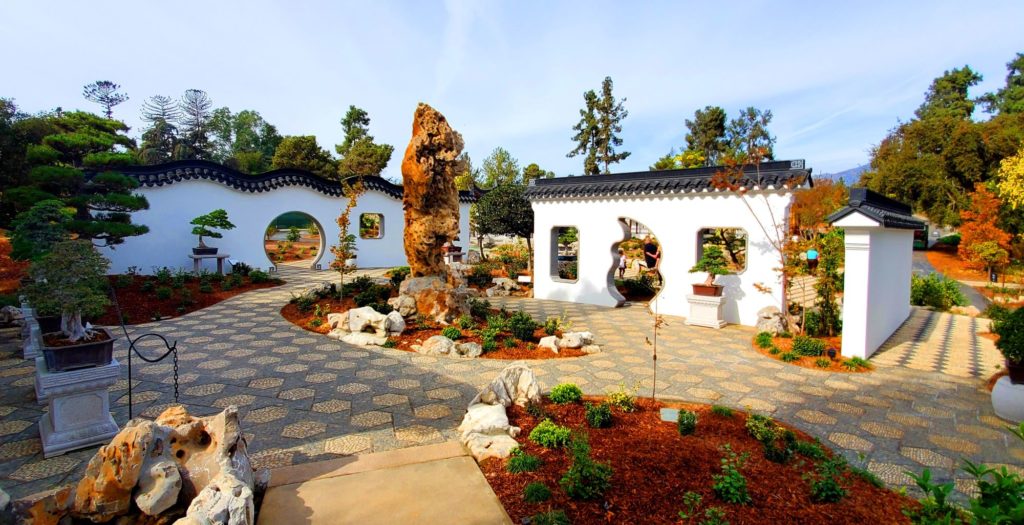
By Greg Aragon
If you are looking for a beautiful and relaxing outdoor getaway for the day, the new Chinese Gardens at the Huntington Library, Art Collections, and Botanical Gardens are a spectacular sight to behold. Reopened to the public in July, the Liu Fang Yuan, or Garden of Flowing Fragrance, is one of the largest classical-style Chinese gardens in the world.
Inspired by the centuries-old Chinese tradition of private gardens, Liu Fang Yuan is filled with Chinese plants and framed by exquisite architecture. The landscape is enriched with references to literature and art. Visitors can find both physical relaxation and mental stimulation when exploring the dramatic 15-acre garden.
Liu Fang Yuan is a tribute to the gardens of Suzhou, a city located near Shanghai in southeastern China. During the Ming dynasty (1368–1644), wealthy scholars and merchants there built tasteful private gardens combining architecture, waterworks, rockeries, plants, and calligraphy. Many of the features in Liu Fang Yuan are modeled on specific Suzhou gardens, eight of which are depicted in the woodcarvings in the Love for the Lotus Pavilion.
Upon entering the gardens, the first thing that struck me was all the peaceful ponds and bridges surrounded by meandering walking paths, hundreds of plants and trees and stunning architecture. One of the highlights is the Stargazing Tower, a hillside pavilion situated on the highest point in the garden. Boasting memorable views of the water, pavilions, treetops, mountains and skies, the tower pays homage to nearby Mt. Wilson Observatory, which is visible from the tower, and to the work of astronomer Edwin Hubble, a neighbor of library founder Henry Huntington. Hubble’s papers are part of the Library’s holdings in the history of science.
Rocks are also an important part of the Suzhou gardens. The stones found throughout Liu Fang Yuan are a type of limestone traditionally harvested from the bed of Lake Tai near Suzhou. The rocks for the Huntington’s exhibits were quarried in various regions of China. For more than 1,200 years, these rocks have been renowned for their strange shapes and many holes. Particularly prized individual specimens, like the towering stone near the teahouse, “Patching Up the Sky,” were seen as embodying energy-like ethers, or “qi.”

Like all Suzhou-style gardens, Liu Fang Yuan has written text on the structures. Every pavilion and courtyard bear a name in Chinese characters. And the entrances to some buildings are also adorned with poetic couplets. These calligraphic inscriptions were written by more than 30 contemporary artists from mainland China, Taiwan, Hong Kong, the United States, and the United Kingdom. The names and couplets that they have inscribed are drawn from classic works of Chinese literature.
Like the text, the construction of the gardens was also a masterful collaboration. Construction of the garden was an international partnership between Chinese and American architects, contractors, and craftsmen who worked together to ensure the gardens are authentic to Chinese traditions of architecture and landscape design, while meeting state and federal regulations for seismic safety and accessibility.
Los Angeles architect Jim Fry developed the detailed construction plans for the expansion, based on the conceptual designs of the Suzhou Institute of Landscape Architecture Design in China. To keep things as authentic as possible, Chinese artisans from the Suzhou Garden Development Co., Ltd. worked on site for several months to complete important details by hand. These craftsmen specialize is skills such as wood carving, roof tiling, and stone masonry.
The 16-acre Chinese Gardens are just one part of the Huntington’s massive outdoor displays. In all, the preserve covers more than 200 acres, of which 120 acres are gardens. In 1903 Henry E. Huntington (1850–1927) purchased the San Marino Ranch, a working ranch about 12 miles from downtown Los Angeles with citrus groves, nut and fruit orchards, alfalfa crops, a small herd of cows, and poultry.
Huntington’s superintendent, William Hertrich (1878–1966), was instrumental in developing the various plant collections that comprise the foundation of The Huntington’s botanical gardens. The property — originally nearly 600 acres — today covers 207 acres, 120 of which are open to visitors and include some 15,000 different varieties of plants.
Other themed gardens at the library include tributes to Australia, Japan, California, children, camellias, the desert, herbs, the jungle, lily ponds, roses, the subtropics, sculptures & fountains, and a mausoleum.
The Huntington’s gardens are currently open, while galleries remain closed. All visitors, including Members must reserve tickets online in advance.
The Huntington Library is located at 1151 Oxford Road, San Marino, CA 91108. For hours and admission, call (626) 405-2100 or visit: huntington.org.






